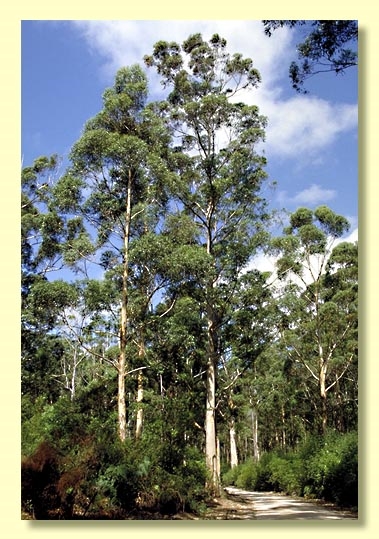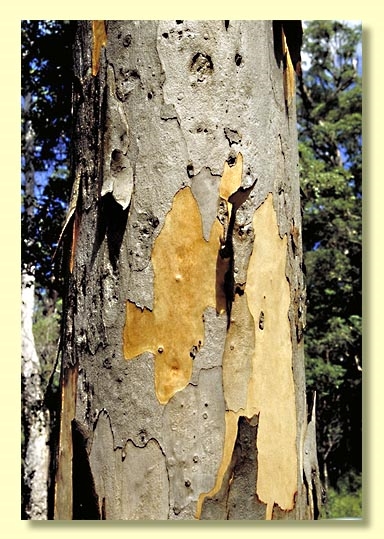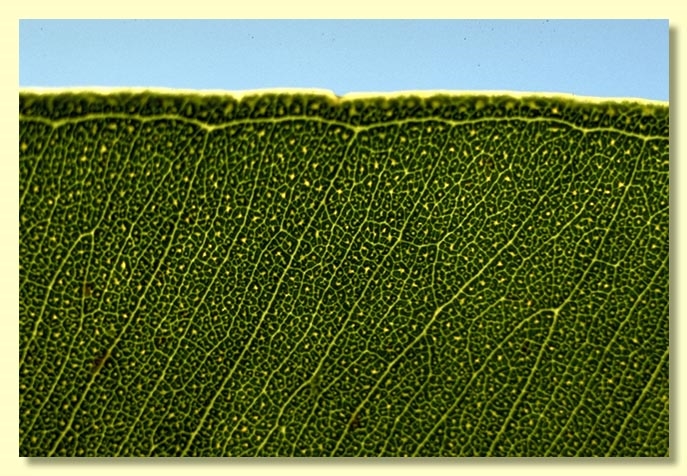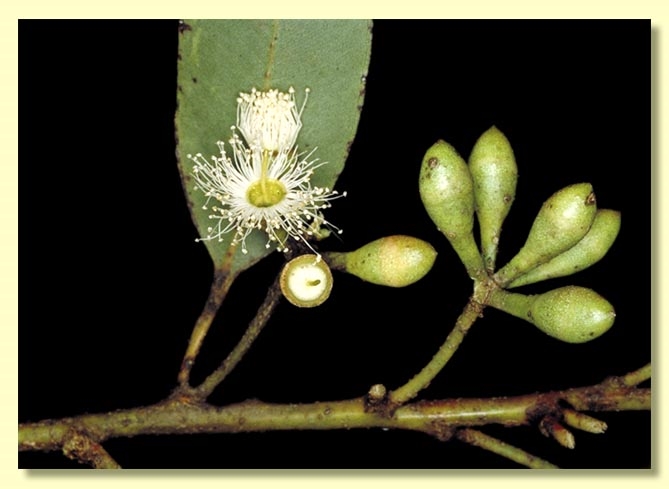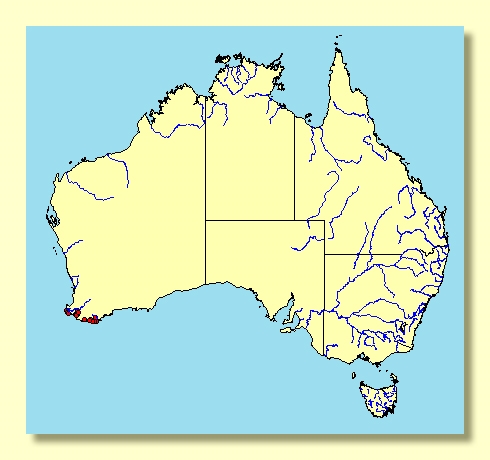Euclid - Online edition
Eucalyptus diversicolor
Eucalyptus | Symphyomyrtus | Inclusae
Bark smooth throughout light grey, dark grey and cream to yellow or pale orange, often mottled, shedding in irregular plates. The smooth surface may become granular with age.
Branchlets lacking oil glands in the pith.
Juvenile growth (coppice or field seedlings to 50 cm): stems rounded in cross-section; juvenile leaves always petiolate, opposite at lowest nodes only then alternate, broadly ovate to sub-orbicular, 5–15.5 cm long, 2.5–10 cm wide, discolorous, dull mid-green above.
Adult leaves alternate, petioles 1–2 cm long; blade lanceolate, 7–13.5 cm long, 1.5–3.7 cm wide, base tapering or oblique, margin entire or subcrenulate, apex a drip-tip, discolorous, dark green and glossy above, paler below, penniveined, reticulation dense, intramarginal vein close to margin, oil glands mostly island, yellow.
Inflorescence axillary unbranched, peduncles rounded to slightly flattened, 1.2–3 cm long, buds 7 per umbel, pedicels 0.3–0.6 cm long. Mature buds ovoid to obovoid (1.1–1.6 cm long, 0.5–0.7 cm wide), outer operculum lost very early and scar obscure at bud maturity, inner operculum broadly conical, stamens inflexed, anthers oblong-cuboid, versatile, dorsifixed, dehiscing by longitudinal slits, style long and straight, stigma more or less blunt, locules 3, the placentae each with 4 vertical rows of ovules. Flowers white.
Fruit pedicellate (pedicels 0.5–0.6 cm long), barrel-shaped, 1–1.2 cm long, (0.7)0.8–1 cm wide, disc descending, valves 3, enclosed or just below rim.
Seeds grey, 1.2–3 mm long, flattened-ovoid and often pointed at one end, dorsal surface smooth, hilum ventral.
Cultivated seedlings (measured at node 10): cotyledons bilobed to oblong; stems square in cross-section; leaves always petiolate, opposite for 6 to 15 nodes then alternate, ovate to broadly elliptical, 4–8 cm long, 2–6 cm wide, discolorous, dull mid-green above.
Flowering has been recorded in January, April, May, August and December.
A tall forest tree endemic to Western Australia, growing in higher rainfall areas of the south-west of Western Australia from Mt Manypeaks and Porongorup Range (but not the Stirling Range) west to Cape Leeuwin and north to Nannup where it can form pure stands on acidic sandy soils. Eucalyptus diversicolor has smooth bark spectacularly orange in season and discolorousadult leaves that are paler green on the underside.
Eucalyptus diversicolor belongs in Eucalyptus subgenus Symphyomyrtus because the buds have two opercula and ovules are in four rows. However it is not closely related to any other species and occupies a solitary position in section Inclusae as the cotyledons are bilobed to oblong, stamens are inflexed, the fruit have enclosed valves, seeds are flattened-ovoid and the branchlets lack pith glands.
E. diversicolor has no closely related species. It has some affinity with eastern Australian tall, wet forest species such as E. grandis and E. saligna, being large forest trees occupying wet habitats and retaining the primitive rainforest character of strongly discolorous adult leaves, and having flattened-ovoid seed. E. diversicolor may also have some more distant relationship with the grey gums of eastern Australia (E. punctata, E. canaliculata, E. longirostrata, E. grisea, E. propinqua, E. major) which share some bark characteristics and also have discolorous leaves but differ in having cuboid seed.
The timber of E. diversicolor is red, hard and beautiful, strong and moderately durable. It is the second most important commercial species in Western Australia used for flooring and building construction.

